Advances in Liquid Metal-Enabled Flexible and Wearable Sensors
Abstract
1. Introduction
2. Materials
2.1. Composition
2.2. Property
3. Fabrication
3.1. Printing Technology
3.2. Microfluidic Technology
3.3. Selective Wetting
3.4. Laser Engraving
3.5. Dewetting and Wiping
4. Basic Principle of Liquid-Metal Sensors
4.1. Liquid Metal as Soft Connection
4.2. Resistive Sensors
4.3. Capacitive Sensors
4.4. Electrochemical Sensors
4.5. Metamaterial Biosensors
4.6. Liquid-Metal Antenna
5. Typical Applications
5.1. Force Sensors
5.2. Temperature Sensors
5.3. Blood Glucose Sensors
5.4. Sensor Array
5.5. Pneumatic Artificial Muscles
5.6. Liquid-Metal Microsphere Sensors
6. Perspective
6.1. Concept of Liquid Sensors
6.2. Working Principle of Liquid Sensors
7. Discussion
8. Conclusion
Author Contributions
Funding
Conflicts of Interest
References
- Webster, J.G. Medical Instrumentation: Application and Design; John Wiley & Sons Inc.: Hoboken, NJ, USA, 1998. [Google Scholar]
- Harsanyi, G. Sensors in Biomedical Applications: Fundamentals, Technology and Applications; CRC Press: Boca Raton, FL, USA, 2000. [Google Scholar]
- Gong, S.; Schwalb, W.; Wang, Y.; Chen, Y.; Tang, Y.; Si, J.; Shirinzadeh, B.; Cheng, W. A wearable and highly sensitive pressure sensor with ultrathin gold nanowires. Nat. Commun. 2014, 5, 1–8. [Google Scholar] [CrossRef] [PubMed]
- Viry, L.; Levi, A.; Totaro, M.; Mondini, A.; Mattoli, V.; Mazzolai, B. Flexible three-axial force sensor for soft and highly sensitive artificial touch. Adv. Mater. 2014, 26, 2659–2664. [Google Scholar] [CrossRef] [PubMed]
- Water, W.; Chen, S.E. Using ZnO nanorods to enhance sensitivity of liquid sensor. Sensor. Actuat. B Chem. 2009, 136, 371–375. [Google Scholar] [CrossRef]
- Schneditz, D.; Kenner, T.; Heimel, H.; Stabinger, H. A sound-speed sensor for the measurement of total protein concentration in disposable, blood-perfused tubes. J. Acoust. Soc. Am. 1989, 86, 2073. [Google Scholar] [CrossRef]
- Zhang, H.; Yang, Y.; Su, Y.; Chen, J.; Adams, K.; Lee, S.; Hu, C.; Wang, Z. Triboelectric nanogenerator for harvesting vibration energy in full space and as self-powered acceleration sensor. Adv. Funct. Mater. 2014, 24, 1401–1407. [Google Scholar] [CrossRef]
- Peet, D.J.; Pryor, M.D. Evaluation of a mosfet radiation sensor for the measurement of entrance surface dose in diagnostic radiology. Br. J. Radiol. 1999, 72, 562–568. [Google Scholar] [CrossRef]
- Yang, H.; Qi, D.; Liu, Z.; Chandran, B.K.; Wang, T.; Yu, J.; Chen, X. Soft thermal sensor with mechanical adaptability. Adv. Mater. 2016, 28, 9175–9181. [Google Scholar] [CrossRef]
- Wang, C.F.; Wang, C.H.; Huang, Z.L.; Xu, S. Materials and structures toward soft electronics. Adv. Mater. 2018, 30. [Google Scholar] [CrossRef]
- Koo, J.H.; Song, J.; Kim, D. Solution-processed thin films of semiconducting carbon nanotubes and their application to soft electronics. Nanotechnology 2019, 30, 13. [Google Scholar] [CrossRef]
- Djenizian, T.; Tee, B.; Ramuz, M.; Fang, L. Advances in flexible and soft electronics. APL Mater. 2019, 7. [Google Scholar] [CrossRef]
- Kang, B.; Lee, S.K.; Jung, J.; Joe, M.; Lee, S.B.; Kim, J.; Lee, C.; Cho, K. Nanopatched graphene with molecular self-assembly toward graphene-organic hybrid soft electronics. Adv. Mater. 2018, 30. [Google Scholar] [CrossRef] [PubMed]
- Zhang, S.; Wang, B.; Jiang, J.; Wu, K.; Guo, C.F.; Wu, Z. High fidelity conformal printing of 3D liquid alloy circuits for soft electronics. ACS Appl. Mater. Inter. 2019, 11, 7148–7156. [Google Scholar] [CrossRef] [PubMed]
- Valentine, A.D.; Busbee, T.A.; Boley, J.W.; Raney, J.R.; Lewis, J.A. Hybrid 3D printing of soft electronics. Adv. Mater. 2017, 29, 29. [Google Scholar] [CrossRef] [PubMed]
- Wang, C.; Xia, K.; Zhang, Y.; Kaplan, D.L. Silk-based advanced materials for soft electronics. Acc. Chem. Res. 2019, 52, 2916–2927. [Google Scholar] [CrossRef]
- Feng, Y.; Zhu, J. Copper nanomaterials and assemblies for soft electronics. Sci. China Mater. 2019, 62, 1679–1708. [Google Scholar] [CrossRef]
- Kang, J.; Tok, J.; Bao, Z. Self-healing soft electronics. Nat. Electron. 2019, 2, 144–150. [Google Scholar] [CrossRef]
- Li, R.; Wang, L.; Yin, L. Materials and devices for biodegradable and soft biomedical electronics. Materials 2018, 11, 2108. [Google Scholar] [CrossRef]
- Choi, C.; Choi, M.K.; Hyeon, T.; Kim, D. Nanomaterial-based soft electronics for healthcare applications. ChemNanoMat 2016, 2. [Google Scholar] [CrossRef]
- Hoshi, T. Robot skin based on touch-area-sensitive tactile element. In Proceedings of the Presented at IEEE International Conference on Robotics & Automation, Orlando, FL, USA, 15–19 May 2006. [Google Scholar]
- Bartlett, M.D.; Markvicka, E.J.; Majidi, C. Rapid fabrication of soft, multilayered electronics for wearable biomonitoring. Adv. Funct. Mater. 2016, 26, 8496–8504. [Google Scholar] [CrossRef]
- Gong, S.; Lai, D.; Su, B.; Si, K.J.; Ma, Z.; Yap, L.W.; Guo, P.; Cheng, W. Highly stretchy black gold E-skin nanopatches as highly sensitive wearable biomedical sensors. Adv. Electron. Mater. 2015, 1. [Google Scholar] [CrossRef]
- Jeong, S.H.; Zhang, S.; Hjort, K.; Hilborn, J.; Wu, Z. PDMS-based elastomer tuned soft, stretchable, and sticky for epidermal electronics. Adv. Mater. 2016, 28, 5830–5836. [Google Scholar] [CrossRef] [PubMed]
- Yuan, W.; Dong, S.; Adelson, E. GelSight: High-resolution robot tactile sensors for estimating geometry and force. Sensors 2017, 17, 2762. [Google Scholar] [CrossRef] [PubMed]
- Tian, L.; Li, Y.; Webb, R.; Krishnan, S.; Bian, Z.; Song, J.; Ning, X.; Crawford, K.; Kurniawan, J.F.; Bofinas, A.P.; et al. Flexible and stretchable 3ω sensors for thermal characterization of human skin. Adv. Funct. Mater. 2017, 27, 26. [Google Scholar] [CrossRef]
- Sonar, H.A.; Paik, J. Soft pneumatic actuator skin with piezoelectric sensors for vibrotactile feedback. Front. Robot. AI 2016, 2, 10–3389. [Google Scholar] [CrossRef]
- Hu, T.; Xuan, S.; Ding, L.; Gong, X. Stretchable and magneto-sensitive strain sensor based on silver nanowire-polyurethane sponge enhanced magnetorheological elastomer. Mater. Des. 2018, 156, 528–537. [Google Scholar] [CrossRef]
- Jiong, Y.; Cheng, W.; Kourosh, K. Electronic skins based on liquid metals. Proc. IEEE 2019, 107, 2168–2184. [Google Scholar]
- Stoppa, M.; Chiolerio, A. Wearable electronics and smart textiles: A critical review. Sensors 2014, 14, 11957–11992. [Google Scholar] [CrossRef]
- Rajan, K.; Garofalo, E.; Chiolerio, A. Wearable Intrinsically Soft, Stretchable, Flexible Devices for Memories and Computing. Sensors 2018, 18, 367. [Google Scholar] [CrossRef]
- Roh, E.; Hwang, B.U.; Kim, D.; Kim, B.Y.; Lee, N.E. Stretchable, transparent, ultrasensitive, and patchable strain sensor for human–machine interfaces comprising a nanohybrid of carbon nanotubes and conductive elastomers. ACS Nano 2015, 9, 6252–6261. [Google Scholar] [CrossRef]
- Chen, S.; Jiang, K.; Lou, Z.; Chen, D.; Shen, G. Recent developments in graphene-based tactile sensors and e-skins. Adv. Mater. Technol. 2017, 3. [Google Scholar] [CrossRef]
- Wang, C.; Xia, K.; Zhang, M.; Jian, M.; Zhang, Y. An all silk-derived, dual-mode e-skin for simultaneous temperature-pressure detection. ACS Appl. Mater. Inter. 2017, 9, 39484–39492. [Google Scholar] [CrossRef] [PubMed]
- Tajima, R.; Kagami, S.; Inaba, M.; Inoue, H. Development of soft and distributed tactile sensors and the application to a humanoid robot. Adv. Robot. 2002, 16, 381–397. [Google Scholar] [CrossRef]
- Ozel, S.; Keskin, N.A.; Khea, D.; Onal, C.D. A precise embedded curvature sensor module for soft-bodied robots. Sensor. Actuat. A Phys. 2015, 236, 349–356. [Google Scholar] [CrossRef]
- Li, S.; Zhao, H.; Shepherd, R.F. Flexible and stretchable sensors for fluidic elastomer actuated soft robots. MRS Bull. 2017, 42, 138–142. [Google Scholar] [CrossRef]
- Yeo, J.C.; Lim, C.T. Emerging flexible and wearable physical sensing platforms for healthcare and biomedical applications. Microsyst. Nanoeng. 2016, 2. [Google Scholar] [CrossRef]
- Dinh, T.; Phan, H.; Nguyen, K.; Qamar, A.; Md Foisal, A.R.; Viet, T.; Tran, C.D.; Zhu, Y.; Nguyen, N.T.; Dao, D.V. Environment-friendly carbon nanotube based flexible electronics for noninvasive and wearable healthcare. J. Mater. Chem. C 2016, 4. [Google Scholar] [CrossRef]
- Wang, D.; Mei, Y.; Huang, G. Printable inorganic nanomaterials for flexible transparent electrodes: From synthesis to application. J. Semicond. 2018, 39. [Google Scholar] [CrossRef]
- Fu, K.; Yao, Y.; Dai, J.; Hu, L. Progress in 3D printing of carbon materials for energy-related applications. Adv. Mater. 2016, 29. [Google Scholar] [CrossRef]
- Choi, Y.; Kang, J.; Secor, E.; Sun, J.; Kim, H.; Lim, J. Capacitively coupled hybrid ion gel and carbon nanotube thin-film transistors for low voltage flexible logic circuits. Adv. Funct. Mater. 2018, 28, 28. [Google Scholar] [CrossRef]
- Zhang, D.; Chi, B.; Li, B.; Gao, Z.; Du, Y.; Guo, J.; Wei, J. Fabrication of highly conductive graphene flexible circuits by 3D printing. Synth. Met. 2016, 27, 79–86. [Google Scholar] [CrossRef]
- Saidina, D.; Eawwiboonthanakit, N.; Jaafar, M.; Fontana, S.; Hérold, C. Recent development of graphene-based ink and other conductive material-based inks for flexible electronics. J. Electron. Mater. 2019, 48, 3428–3450. [Google Scholar] [CrossRef]
- Yang, W.; Wang, C. Graphene and the related conductive inks for flexible electronics. J. Mater. Chem. C 2016, 4, 7193–7207. [Google Scholar] [CrossRef]
- Park, J.; Zhou, C.; Yang, C.Y. Carbon-based Nanostructures for Flexible Electronics. In Proceedings of the IEEE International Conference on Electron Devices and Solid State Circuits, Shenzhen, China, 6–8 June 2018. [Google Scholar]
- Hao, Y.; Gao, J.; Xu, Z.; Zhang, N.; Luo, J.; Liu, X. Preparation of silver nanoparticles with hyperbranched polymers as a stabilizer for inkjet printing of flexible circuits. New J. Chem. 2019, 43, 2797–2803. [Google Scholar] [CrossRef]
- Stephan, T.D.; Vimolvan, P. Humic acid assisted synthesis of silver nanoparticles and its application to herbicide detection. Mater. Lett. 2008, 62, 2661–2663. [Google Scholar]
- Sun, J.; Zhou, W.; Yang, H.; Zhen, X.; Ma, L.; Williams, D.; Sun, D.; Lang, M. Highly transparent and flexible circuits through patterning silver nanowires into microfluidic channels. Chem. Commun. 2018, 54, 4923–4926. [Google Scholar] [CrossRef]
- Seung, H.K. Low temperature thermal engineering of nanoparticle ink for flexible electronics applications. Semicond. Sci. Technol. 2016, 31, 31. [Google Scholar] [CrossRef]
- Tan, S.; Zu, X.; Yi, G.; Liu, X. Synthesis of highly environmental stable copper-silver core-shell nanoparticles for direct writing flexible electronics. J. Mater. Sci. Mater. Electron. 2017, 28, 15899–15906. [Google Scholar] [CrossRef]
- Shao, W.; Li, G.; Zhu, P.; Zhang, Y.; Ouyang, Q.; Sun, R.; Chen, C.; Wong, C.P. Facile synthesis of low temperature sintering Ag nanopaticles for printed flexible electronics. J. Mater. Sci. Mater. Electron. 2018, 29, 4432–4440. [Google Scholar] [CrossRef]
- Chiolerio, A.; Rajan Roppolo, I.; Chiappone, A.; Bocchini, S.; Perrone, D. Silver nanoparticle ink technology: State of the art. Nanotech. Sci. Appl. 2016, 9, 1. [Google Scholar] [CrossRef]
- Yi, L.; Liu, J. Liquid metal biomaterials: A newly emerging area to tackle modern biomedical challenges. Inter. Mater. Rev. 2017, 62, 1–26. [Google Scholar] [CrossRef]
- Wang, Q.; Yu, Y.; Liu, J. Preparations, characteristics and applications of the functional liquid metal materials. Adv. Eng. Mater. 2017, 20. [Google Scholar] [CrossRef]
- Jackson, N.; Buckley, J.; Clarke, C.; Stam, F. Manufacturing methods of stretchable liquid metal-based antenna. Microsyst. Technol. 2019, 25, 3175–3184. [Google Scholar] [CrossRef]
- Ordonez, R.; Hayashi, C.; Torres, C.; Hafner, N.; Adleman, J.; Acosta, N.; Melcher, J.; Kamin, N.M.; Garmire, D. Conformal Liquid-Metal Electrodes for Flexible Graphene Device Interconnects. IEEE Trans. Electron Dev. 2016, 63, 4018–4023. [Google Scholar] [CrossRef]
- Li, Q.; Lin, J.; Liu, T.; Zheng, H.; Liu, J. Printed flexible thin-film transistors based on different types of modified liquid metal with good mobility. Sci. China Informa. Sci. 2019, 62. [Google Scholar] [CrossRef]
- Nayak, S.; Li, Y.; Tay, W.; Zamburg, E.; Singh, D.; Lee, C.; Koh, S.J.A.; Chia, P.; Thean, A.V.Y. Liquid-metal-elastomer foam for moldable multi-functional triboelectric energy harvesting and force sensing. Nano Energy 2019, 64. [Google Scholar] [CrossRef]
- Kim, S.; Oh, J.; Jeong, D.; Bae, J. Direct wiring of eutectic gallium-indium to a metal electrode for soft sensor systems. ACS Appl. Mater. Inter. 2019, 11, 20557–20565. [Google Scholar] [CrossRef] [PubMed]
- Kim, T.; Kim, D.; Lee, B.; Lee, J. Soft and Deformable Sensors Based on Liquid Metals. Sensors 2019, 19, 4250. [Google Scholar] [CrossRef]
- Yang, Y.; Jie, Z.; Jing, L.; Sabato, D. Biomedical implementation of liquid metal ink as drawable ECG electrode and skin circuit. PLoS ONE 2013, 8. [Google Scholar] [CrossRef]
- Zhao, Z.N.; Ju, L.; Jie, Z.; Yang, Y.; Bo, Y.; Fan, C.C.; Wang, L.; Liu, J. Liquid metal enabled flexible electronic system for eye movement tracking. IEEE Sens. J. 2018, 18, 2592–2598. [Google Scholar] [CrossRef]
- Jin, C.; Zhang, J.; Li, X.; Yang, X.; Li, J.; Liu, J. Injectable 3-D fabrication of medical electronics at the target biological tissues. Sci. Rep. 2013, 3, 3442. [Google Scholar] [CrossRef]
- Sun, X.; Yuan, B.; Rao, W.; Liu, J. Amorphous liquid metal electrodes enabled conformable electrochemical therapy of tumors. Biomaterials 2017, 146, 156–167. [Google Scholar] [CrossRef] [PubMed]
- Varga, M.; Ladd, C.; Ma, S.; Holbery, J.; Tröster, G. On-skin liquid metal inertial sensor. Lab. Chip. 2017, 17, 3272–3278. [Google Scholar] [CrossRef] [PubMed]
- Chiolerio, A.; Quadrelli, M. Smart Fluid Systems: The advent of autonomous liquid robotics. Adv. Sci. 2017, 4. [Google Scholar] [CrossRef] [PubMed]
- Adamatzky, A.; Chiolerio, A.; Szacilowski, K. Liquid metal solves maze. Soft Matter 2019. [CrossRef]
- Zhang, Q.; Zheng, Y.; Liu, J. Direct writing of electronics based on alloy and metal (dream) ink: A newly emerging area and its impact on energy, environment and health sciences. Front. Energy. 2012, 6, 311–340. [Google Scholar] [CrossRef]
- Guo, R.; Wang, X.; Chang, H.; Yu, W.; Liang, S.; Rao, W. Ni-GaIn amalgams enabled rapid and customizable fabrication of wearable and wireless healthcare electronics. Adv. Eng. Mater. 2018, 20. [Google Scholar] [CrossRef]
- Chang, H.; Guo, R.; Sun, Z.Q.; Wang, H.Z.; Hou, Y.; Wang, Q.; Rao, W.; Liu, J. Flexible conductive materials: Direct writing and repairable paper flexible electronics using nickel-liquid metal ink. Adv. Mater. Interfaces 2018, 5. [Google Scholar] [CrossRef]
- Guo, R.; Yao, S.; Sun, X.; Liu, J. Semi-liquid metal and adhesion-selection enabled rolling and transfer (SMART) printing: A general method towards fast fabrication of flexible electronics. Sci. China Mater. 2019, 62, 982–994. [Google Scholar] [CrossRef]
- Tang, J.; Zhao, X.; Li, J.; Guo, R.; Zhou, Y.; Liu, J. Gallium-based liquid metal amalgams: Transitional-state metallic mixtures (TransM2ixes) with enhanced and tunable electrical, thermal, and mechanical properties. ACS Appl. Mater. Interfaces 2017, 9, 35977–35987. [Google Scholar] [CrossRef]
- Li, H.; Mei, S.; Wang, L.; Gao, Y.; Liu, J. Splashing phenomena of room temperature liquid metal droplet striking on the pool of the same liquid under ambient air environment. Inter. J. Heat Fluid FL 2014, 47, 1–8. [Google Scholar] [CrossRef]
- Liu, T.; Sen, P.; Kim, C.J. Characterization of nontoxic liquid-metal alloy galinstan for applications in microdevices. J. Microelectromech. Syst. 2012, 21, 443–450. [Google Scholar] [CrossRef]
- Kim, D.; Lee, J.B. Magnetic-field-induced liquid metal droplet manipulation. J. Korean Phys. Soc. 2015, 66, 282–286. [Google Scholar] [CrossRef]
- Ren, Y.; Liu, J. Liquid-metal enabled droplet circuits. Micromachines 2018, 9, 218. [Google Scholar] [CrossRef] [PubMed]
- Tan, S.C.; Yuan, B.; Liu, J. Electrical method to control the running direction and speed of self-powered tiny liquid metal motors. Proc. Roy. Soc. A Math. Phy. 2015, 471, 32–38. [Google Scholar] [CrossRef]
- Khondoker, M.A.H.; Sameoto, D. Fabrication methods and applications of microstructured gallium based liquid metal alloys. Smart Mater. Struct. 2016, 25. [Google Scholar] [CrossRef]
- Gao, Y.; Li, H.; Liu, J. Direct writing of flexible electronics through room temperature liquid metal ink. PLoS ONE 2012, 7. [Google Scholar] [CrossRef]
- Wang, L.; Liu, J. Advances in the Development of Liquid Metal-Based Printed Electronic Inks. Front. Mater. 2019, 6. [Google Scholar] [CrossRef]
- Sheng, L.; Teo, S.; Liu, J. Liquid-metal-painted stretchable capacitor sensors for wearable healthcare electronics. J. Med. Biol. Eng. 2016, 36, 265–272. [Google Scholar] [CrossRef]
- Zheng, Y.; Zhang, Q.; Liu, J. Pervasive liquid metal based direct writing electronics with roller-ball pen. AIP Adv. 2013, 3, 6459–6463. [Google Scholar] [CrossRef]
- Zheng, Y.; He, Z.; Gao, Y.; Liu, J. Direct desktop printed-circuits-on-paper flexible electronics. Sci. Rep. 2013, 3, 1786. [Google Scholar] [CrossRef]
- Tabatabai, A.; Fassler, A.; Usiak, C.; Majidi, C. Liquid-phase gallium–indium alloy electronics with microcontact printing. Langmuir 2013, 29, 6194–6200. [Google Scholar] [CrossRef] [PubMed]
- Wang, Q.; Yu, Y.; Yang, J.; Liu, J. Fast fabrication of flexible functional circuits based on liquid metal dual-trans printing. Adv. Mater. 2015, 27, 7109–7116. [Google Scholar] [CrossRef] [PubMed]
- Votzke, C.; Daalkhaijav, U.; Mengüç, Y.; Johnston, M. Highly-stretchable biomechanical strain sensor using printed liquid metal paste. In Proceedings of the IEEE Biomedical Circuits and Systems Conference, Cleveland, OH, USA, 17–19 October 2018. [Google Scholar]
- Gannarapu, A.; Gozen, B.A. Freeze-printing of liquid metal alloys for manufacturing of 3D, conductive, and flexible networks. Adv. Mater. Technol. 2016, 1. [Google Scholar] [CrossRef]
- Liang, B.; Wei, J.; Fang, L.; Cao, Q.; Tu, T.; Ren, H. High-resolution rapid prototyping of liquid metal electronics by direct Writing on Highly Prestretched Substrates. ACS Omega 2019, 4, 21072–21077. [Google Scholar] [CrossRef] [PubMed]
- Zhang, Q.; Gao, Y.; Liu, J. Atomized spraying of liquid metal droplets on desired substrate surfaces as a generalized way for ubiquitous printed electronics. Appl. Phys. A 2013, 116, 1091–1097. [Google Scholar]
- Roberts, P.; Damian, D.D.; Shan, W.; Lu, T.; Majidi, C. Soft-matter capacitive sensor for measuring shear and pressure deformation. In Proceedings of the 2013 IEEE International Conference on Robotics and Automation (ICRA), Karlsruhe, Germany, 6–10 May 2013. [Google Scholar]
- Jeong, S.H.; Hagman, A.; Hjort, K.; Jobs, M.; Sundqvist, J.; Wu, Z. Liquid alloy printing of microfluidic stretchable electronics. Lab. Chip. 2012, 12, 4657. [Google Scholar] [CrossRef]
- Kim, K.; Choi, J.; Jeong, Y.; Cho, I.; Kim, M.; Kim, S.; Oh, Y.; Park, I. Highly Sensitive and Wearable Liquid Metal-Based Pressure Sensor for Health Monitoring Applications: Integration of a 3D-Printed Microbump Array with the Microchannel. Adv. Healthc. Mater. 2019, 8. [Google Scholar] [CrossRef]
- Wong, R.D.P.; Posner, J.D.; Santos, V.J. Flexible microfluidic normal force sensor skin for tactile feedback. Sensor. Actuat. A Phys. 2012, 179, 62–69. [Google Scholar] [CrossRef]
- Taekeon, J.; Yang, S. Highly stable liquid metal-based pressure sensor integrated with a microfluidic channel. Sensors 2015, 15, 11823–11835. [Google Scholar]
- Zhang, L.J.; Gao, M.; Wang, R.H.; Deng, Z.; Gui, L. Stretchable pressure sensor with leakage-free liquid-metal electrodes. Sensors 2019, 19, 1316. [Google Scholar] [CrossRef]
- Yang, Y.; Sun, N.; Wen, Z.; Cheng, P.; Lee, S.T. Liquid metal-based super-stretchable and structure-designable triboelectric nanogenerator for wearable electronics. ACS Nano 2018, 12, 2027–2034. [Google Scholar] [CrossRef] [PubMed]
- Khoshmanesh, K.; Tang, S.; Zhu, J.; Schaefer, S.; Mitchell, A.; Kalantar-zadeh, K.; Dickey, M.D. Liquid Metal Enabled Microfluidics. Lab Chip. 2017, 17, 974–993. [Google Scholar] [CrossRef] [PubMed]
- Gao, M.; Gui, L. Development of a fast thermal response microfluidic system using liquid metal. J. Micromech. Microeng. 2016, 26. [Google Scholar] [CrossRef]
- Kramer, R.K.; Majidi, C.; Wood, R.J. Masked deposition of gallium-indium alloys for liquid-embedded elastomer conductors. Adv. Funct. Mater. 2013, 23, 5292–5296. [Google Scholar] [CrossRef]
- Li, G.; Lee, D.W. Advanced selective liquid-metal plating technique for stretchable biosensor applications. Lab. Chip. 2017, 17. [Google Scholar] [CrossRef]
- Lu, T.; Finkenauer, L.; Wissman, J.; Majidi, C. Rapid prototyping for soft-matter electronics. Adv. Funct. Mater. 2014, 24, 3351–3356. [Google Scholar] [CrossRef]
- Pan, C.; Kumar, K.; Li, J.; Markvicka, E.; Herman, P.R.; Majidi, C. Visually imperceptible liquid-metal circuits for transparent, stretchable electronics with direct laser writing. Adv Mater. 2018, 30, 10–1002. [Google Scholar] [CrossRef]
- Kim, T.; Kim, K.; Kim, S.; Lee, J.; Kim, W. Micropatterning of liquid metal by dewetting. J. Microelectromech. Syst. 2017, 99, 1–4. [Google Scholar] [CrossRef]
- Ren, Y.; Wang, X.L.; Liu, J. Fabrication of High-Resolution Flexible Circuits and Sensors based on Liquid Metal Inks by Spraying and Wiping Processing. IEEE Trans. Biomed. Circ. Syst. 2019, 1, 1545–1551. [Google Scholar] [CrossRef]
- Hong, S.Y.; Lee, Y.H.; Park, H.; Jin, S.W.; Jeong, Y.R.; Yun, J.; You, I.; Zi, G.; Ha, J.S. Stretchable active matrix temperature sensor array of polyaniline nanofibers for electronic skin. Adv. Mater. 2016, 28, 930–935. [Google Scholar] [CrossRef]
- Jiao, Y.; Young, C.; Yang, S.; Oren, S.; Ceylan, H.; Kim, S. Wearable graphene sensors with microfluidic liquid metal wiring for structural health monitoring and human body motion sensing. IEEE Sensor. J. 2016, 16, 7870–7875. [Google Scholar] [CrossRef]
- Hu, H.; Shaikh, K.; Liu, C. Super flexible sensor skin using liquid metal as interconnect. IEEE Sensor. 2007, 815–817. [Google Scholar] [CrossRef]
- Li, H.; Yang, Y.; Liu, J. Printable tiny thermocouple by liquid metal gallium and its matching metal. Appl. Phys. Lett. 2012, 101. [Google Scholar] [CrossRef]
- Mohammed, M.G.; Kramer, R. All-printed flexible and stretchable electronics. Adv. Mater. 2017, 29. [Google Scholar] [CrossRef] [PubMed]
- Otake, S.; Konishi, S. Integration of flexible strain sensor using liquid metal into soft micro-actuator. In Proceedings of the IEEE Micro Electro Mechanical Systems (MEMS), Belfast, UK, 21–25 January 2018. [Google Scholar]
- Vogt, D.M.; Park, Y.L.; Wood, R.J. Design and characterization of a soft multi-axis force sensor using embedded microfluidic channels. IEEE Sensor. J. 2013, 13, 4056–4064. [Google Scholar] [CrossRef]
- Ali, S.; Maddipatla, D.; Narakathu, B.B.; Chlaihawi, A.A.; Emamian, S.; Janabi, F.; Bazuin, B.J.; Atashbar, M.Z. Flexible capacitive pressure sensor based on PDMS substrate and Ga-In liquid metal. IEEE Sensor J. 2018, 19, 97–104. [Google Scholar] [CrossRef]
- Cooper, C.B.; Arutselvan, K.; Liu, Y.; Armstrong, D.; Lin, Y.; Khan, M.R.; Genzer, J.; Dickey, M.D. Stretchable capacitive sensors of torsion, strain, and touch using double helix liquid metal fibers. Adv. Funct. Mater. 2017, 27. [Google Scholar] [CrossRef]
- Zhang, R.; Ye, Z.; Gao, M.; Gao, C.; Zhang, X.; Li, L.; Gui, L. Liquid metal electrode-enabled flexible microdroplet sensor. Lab. Chip. 2019, 20, 496–504. [Google Scholar] [CrossRef]
- Zhang, J.; Yao, Y.; Sheng, L.; Liu, J. Self-Fueled Biomimetic Liquid Metal Mollusk. Adv. Mater. 2015, 27, 2648–2655. [Google Scholar] [CrossRef]
- Sivan, V.; Tang, S.; O'Mullane, A.; Petersen, P.; Eshtiaghi, N.; Kalantar Zadeh, K.; Mitchell, A. Enhanced electrochemical heavy metal ion sensor using liquid metal marbles - towards on-chip application. In Proceedings of the Optoelectronic & Microelectronic Materials & Devices, Melbourne, VIC, Australia, 12–14 December 2012. [Google Scholar]
- Xu, J.; Fan, Y.; Yang, R.; Fu, Q.; Zhang, F. Realization of switchable EIT metamaterial by exploiting fluidity of liquid metal. Opt. Express. 2019, 27, 2837–2843. [Google Scholar] [CrossRef]
- Ling, K.; Kim, K.; Lim, S. Flexible liquid metal-filled metamaterial absorber on polydimethylsiloxane (PDMS). Opt. Express. 2015, 23, 21375–21383. [Google Scholar] [CrossRef] [PubMed]
- Kyeongseob, K.; Dongju, L.; Seunghyun, E.; Sungjoon, L. Stretchable metamaterial absorber using liquid metal-filled polydimethylsiloxane (PDMS). Sensor 2016, 16, 521. [Google Scholar]
- Kenyu, L.; Hyung, K.; Minyeong, Y.; Sungjoon, L. Frequency-switchable metamaterial absorber injecting eutectic gallium-indium (EGaIn) liquid metal alloy. Sensor 2015, 15, 28154–28165. [Google Scholar]
- Reichel, K.S.; Lozada-Smith, N.; Joshipura, I.D.; Ma, J.J.; Shrestha, R.; Mendis, R.; Dickey, M.D.; Mittleman, D.M. Electrically reconfigurable terahertz signal processing devices using liquid metal components. Nat. Commun. 2018, 9, 4203. [Google Scholar] [CrossRef]
- Roychoudhury, S.; Rawat, V.; Jalal, A.H.; Kale, S.N.; Bhansali, S. Recent advances in metamaterial split-ring-resonator circuits as biosensors and therapeutic agents. Biosens. Bioelectron. 2016, 86, 595–608. [Google Scholar] [CrossRef]
- Rodrigo, D.; Jofre, L.; Cetiner, B. Circular beam-steering reconfigurable antenna with liquid metal parasitics. IEEE Trans. Antenn. Propag. 2012, 60, 1796–1802. [Google Scholar] [CrossRef]
- Mazlouman, S.; Jiang, X.; Menon, C.; Vaughan, R. A reconfigurable patch antenna using liquid metal embedded in a silicone substrate. IEEE Trans. Antenn. Propag. 2011, 59, 4406–4412. [Google Scholar] [CrossRef]
- Hayes, G.; So, J.; Qusba, A.; Dickey, M.; Lazzi, G. Flexible liquid metal alloy (EGaIn) microstrip patch antenna. IEEE Trans. Antenn. Propag. 2012, 60, 2151–2156. [Google Scholar] [CrossRef]
- Cheng, S.; Wu, Z.; Hallbjorner, P.; Hjort, K.; Rydberg, A. Foldable and stretchable liquid metal planar inverted cone antenna. IEEE Trans. Antenn. Propag. 2012, 57, 3765–3771. [Google Scholar] [CrossRef]
- Oh, J.; Woo, J.; Jo, S.; Han, C. Pressure-conductive rubber sensor based on liquid-metal-PDMS composite. Sensor. Actual. A Phys. 2019, 299. [Google Scholar] [CrossRef]
- Zhou, Y.; Wu, Y.; Asghar, W.; Ding, J.; Su, X.; Li, S. Asymmetric Structure Based Flexible Strain Sensor for Simultaneous Detection of Various Human Joint Motions. ACS Appl. Electron. Mater. 2019, 1, 1866–1872. [Google Scholar] [CrossRef]
- Shi, X.; Cheng, C.H. Artificial hair cell sensors using liquid metal alloy as piezoresistors. In Proceedings of the IEEE International Conference on Nano/micro Engineered & Molecular Systems, Suzhou, China, 7–10 April 2013. [Google Scholar]
- Liao, M.; Liao, H.; Ye, J.; Wan, P.; Zhang, L. Polyvinyl alcohol-stabilized liquid metal hydrogel for wearable transient epidermal sensors. ACS Appl. Mater. Inter. 2019, 11, 47358–47364. [Google Scholar] [CrossRef] [PubMed]
- Kim, J.; Lee, M.; Shim, H.J.; Ghaffari, R.; Cho, H.R.; Son, D.; Jung, Y.H.; Soh, M.; Choi, C.; Jung, S.; et al. Stretchable silicon nanoribbon electronics for skin prosthesis. Nat. Commun. 2014, 5. [Google Scholar] [CrossRef] [PubMed]
- Spina, F.; Pouryazdan, A.; Costa, J.; Ponce, C.L.; Münzenrieder, N. Directly 3D-printed monolithic soft robotic gripper with liquid metal microchannels for tactile sensing. Flex. Print. Electron. 2019, 4. [Google Scholar] [CrossRef]
- Yi, L.; Li, J.; Guo, C.; Li, L.; Liu, J. Liquid metal ink enabled rapid prototyping of electrochemical sensor for wireless glucose detection on the platform of mobile phone. J. Med. Devices. 2015, 9. [Google Scholar] [CrossRef]
- Feng, Y.; Huang, X.; Liu, S.; Guo, W.; Li, Y.; Wu, H. A self-powered smart safety belt enabled by triboelectric nanogenerators for driving status monitoring. Nano Energy 2019, 62, 197–204. [Google Scholar] [CrossRef]
- Wang, H.; Xiang, Z.; Giorgia, P.; Mu, X.; Yang, Y.; Wang, Z.L.; Lee, C. Triboelectric liquid volume sensor for self-powered lab-on-chip applications. Nano Energy 2016, 23, 80–88. [Google Scholar] [CrossRef]
- Wirekoh, J.; Valle, L.; Po, N.; Park, Y.L. Sensorized, flat, pneumatic artificial muscle embedded with biomimetic microfluidic sensors for proprioceptive feedback. Soft Robot. 2019, 6, 768–777. [Google Scholar] [CrossRef]
- Lin, P.; Zhan, W.Z.; Yan, Q.; Xie, J.; Fan, Y.; Wu, M.; Chen, Y.; Cheng, Z. Capillary-based microfluidic fabrication of liquid metal microspheres toward functional microelectrodes and photothermal medium. ACS Appl. Mater. Interfaces 2019, 11, 25295–25305. [Google Scholar] [CrossRef]
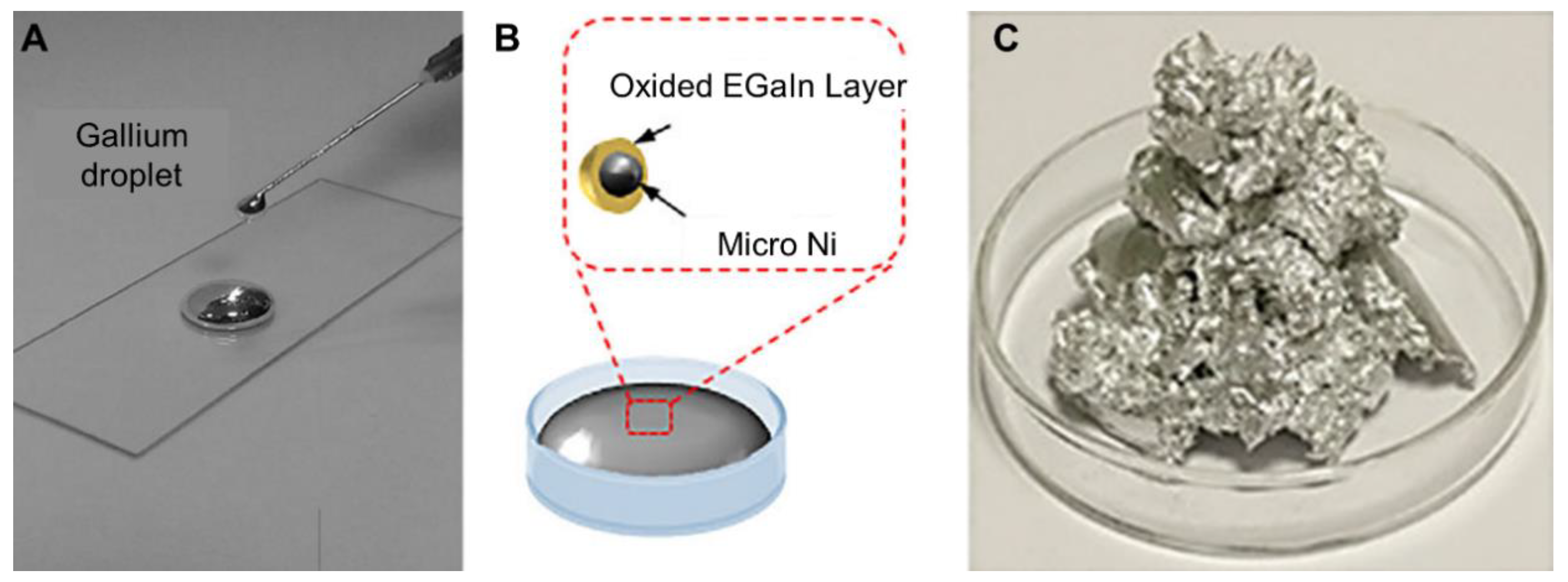
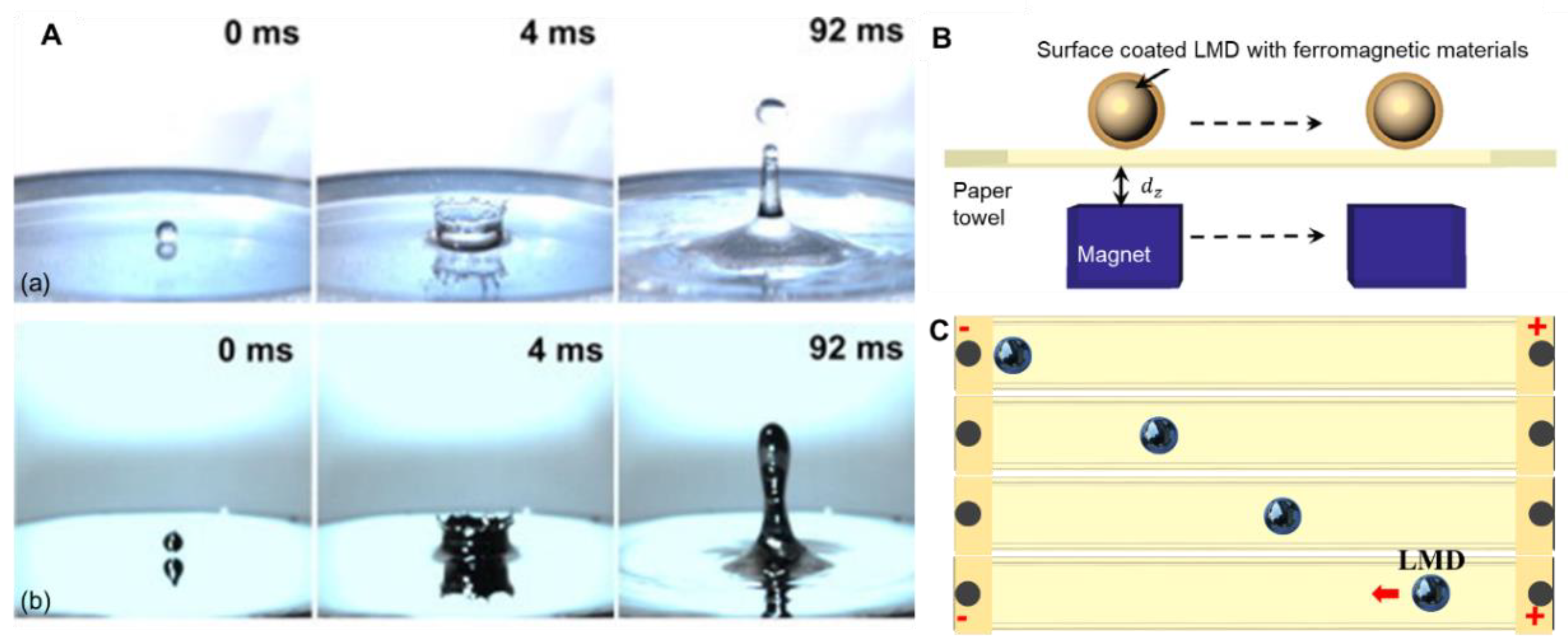

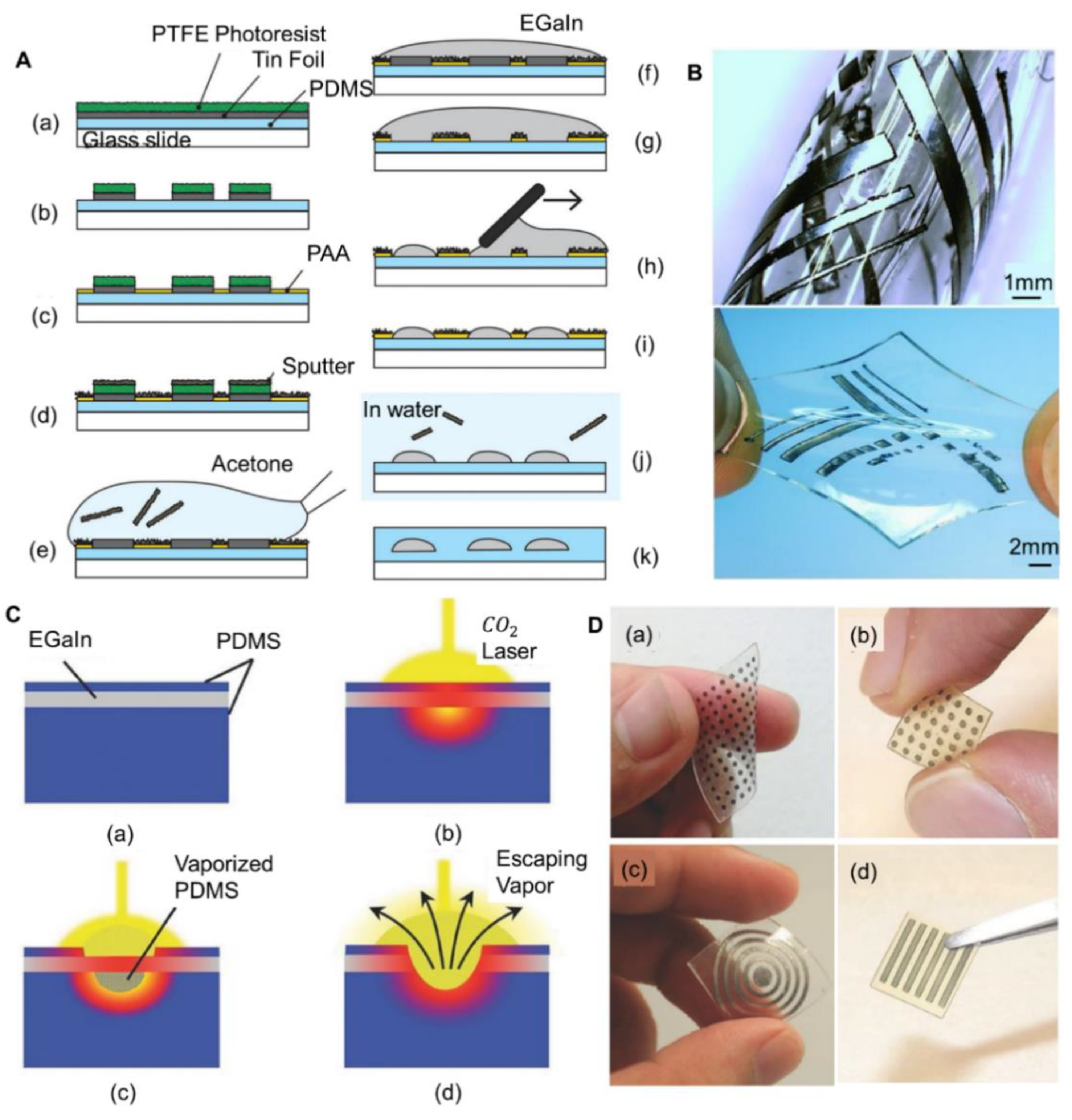
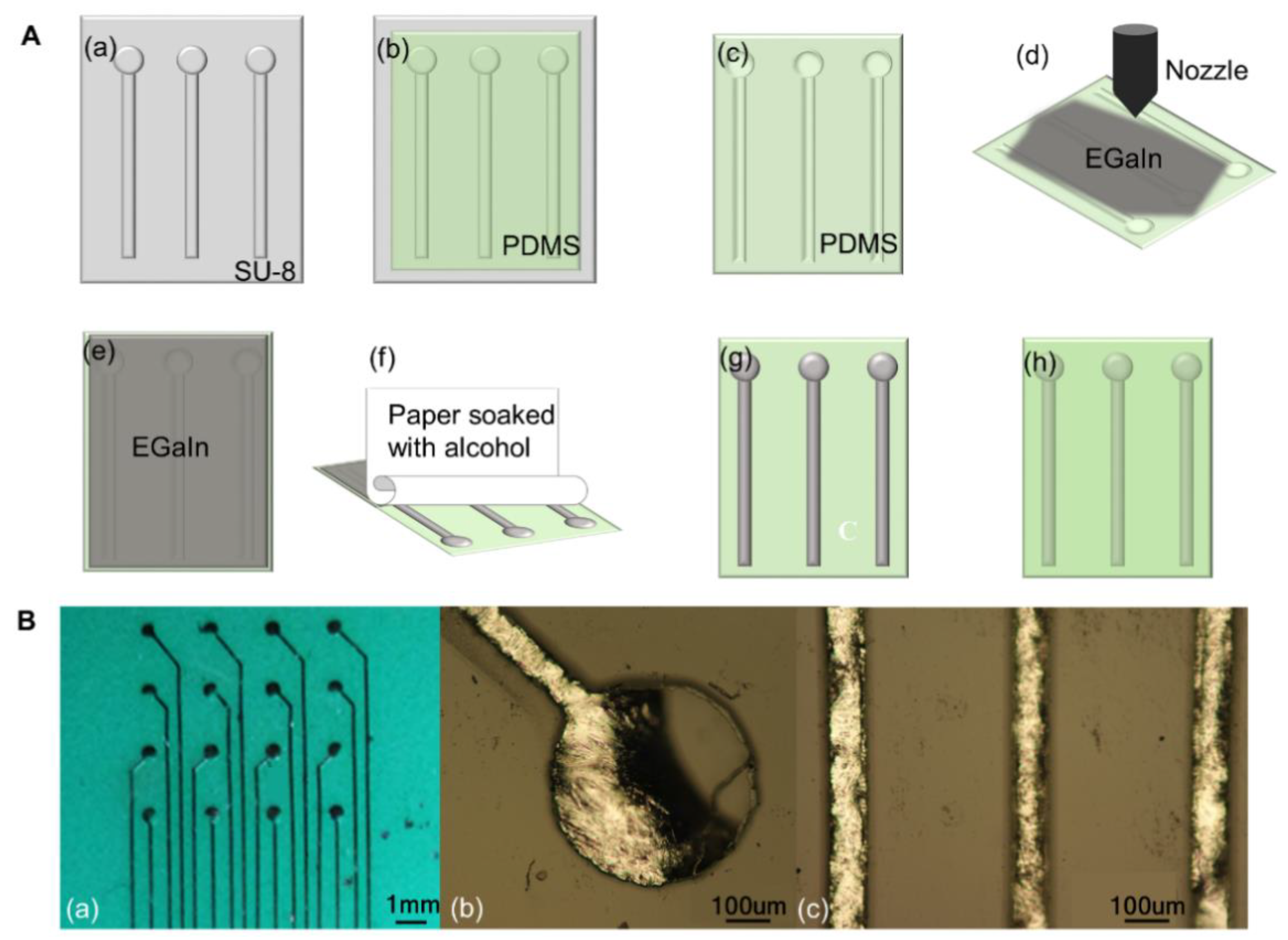
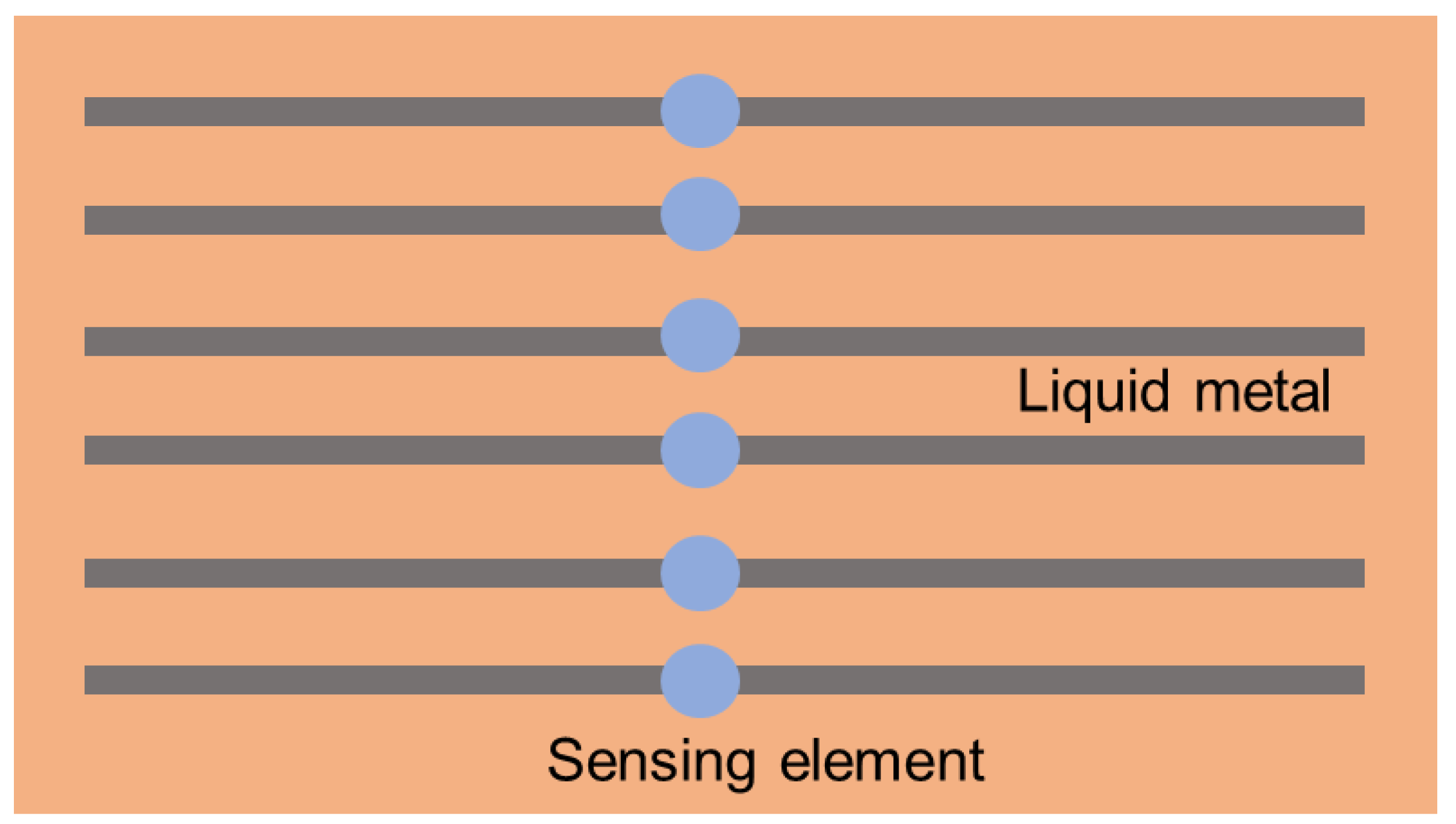
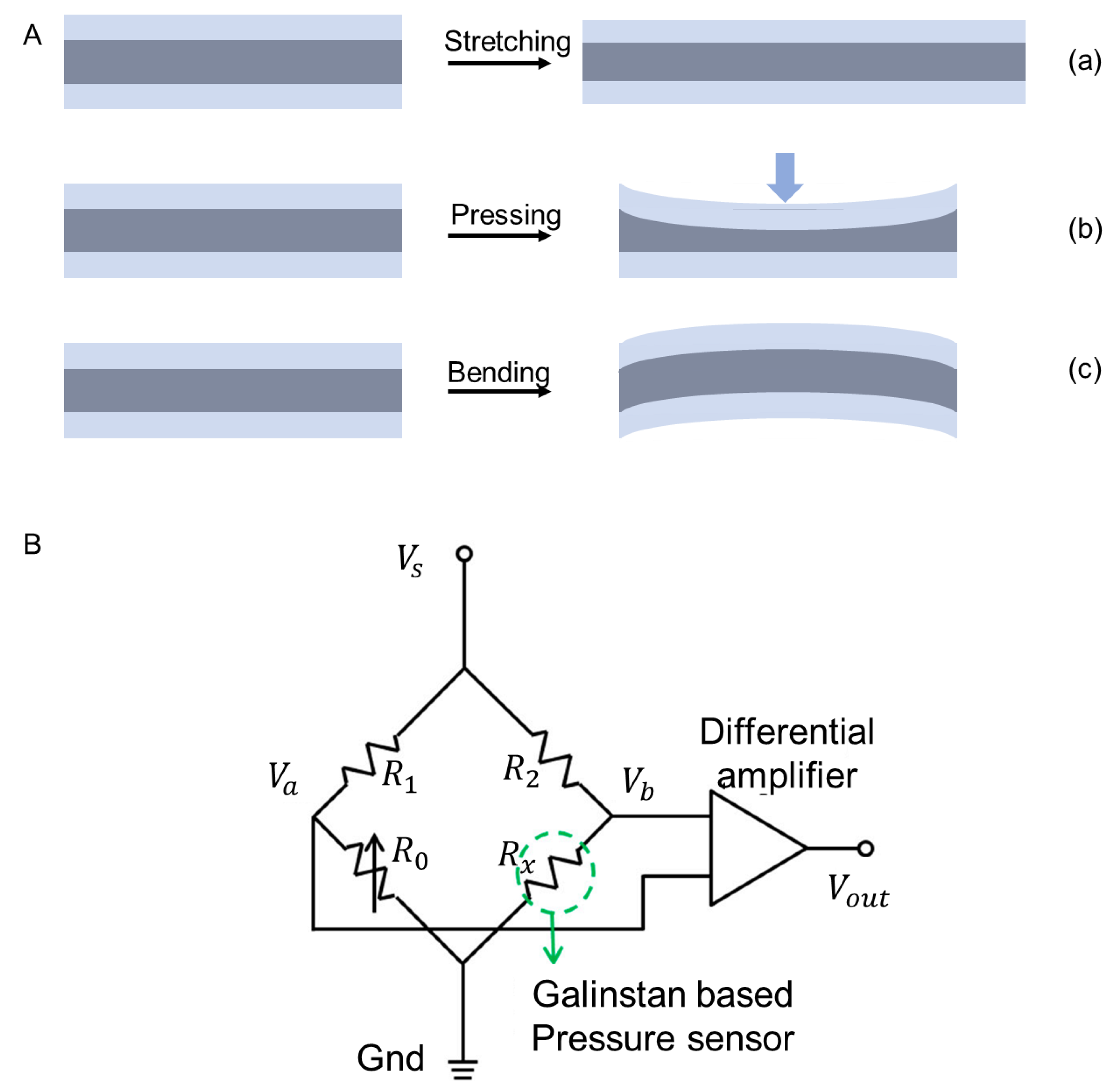
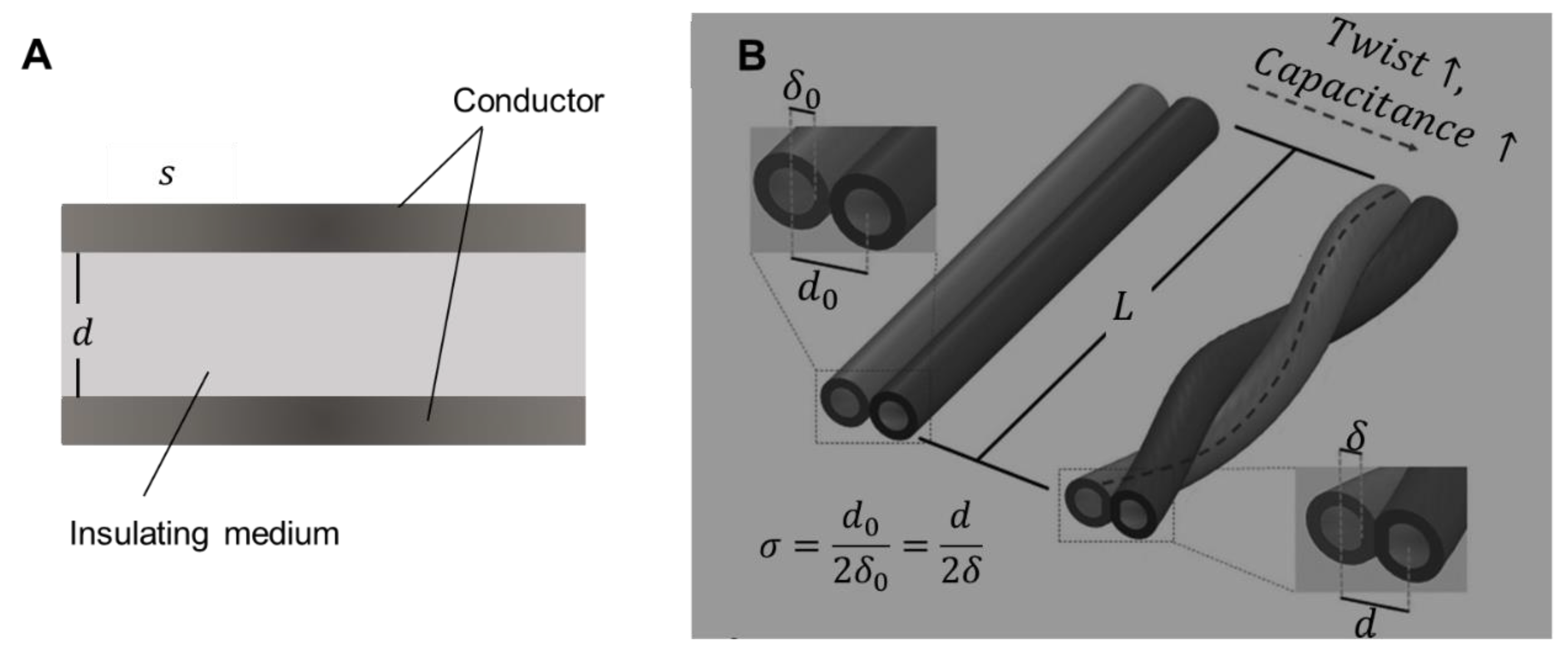
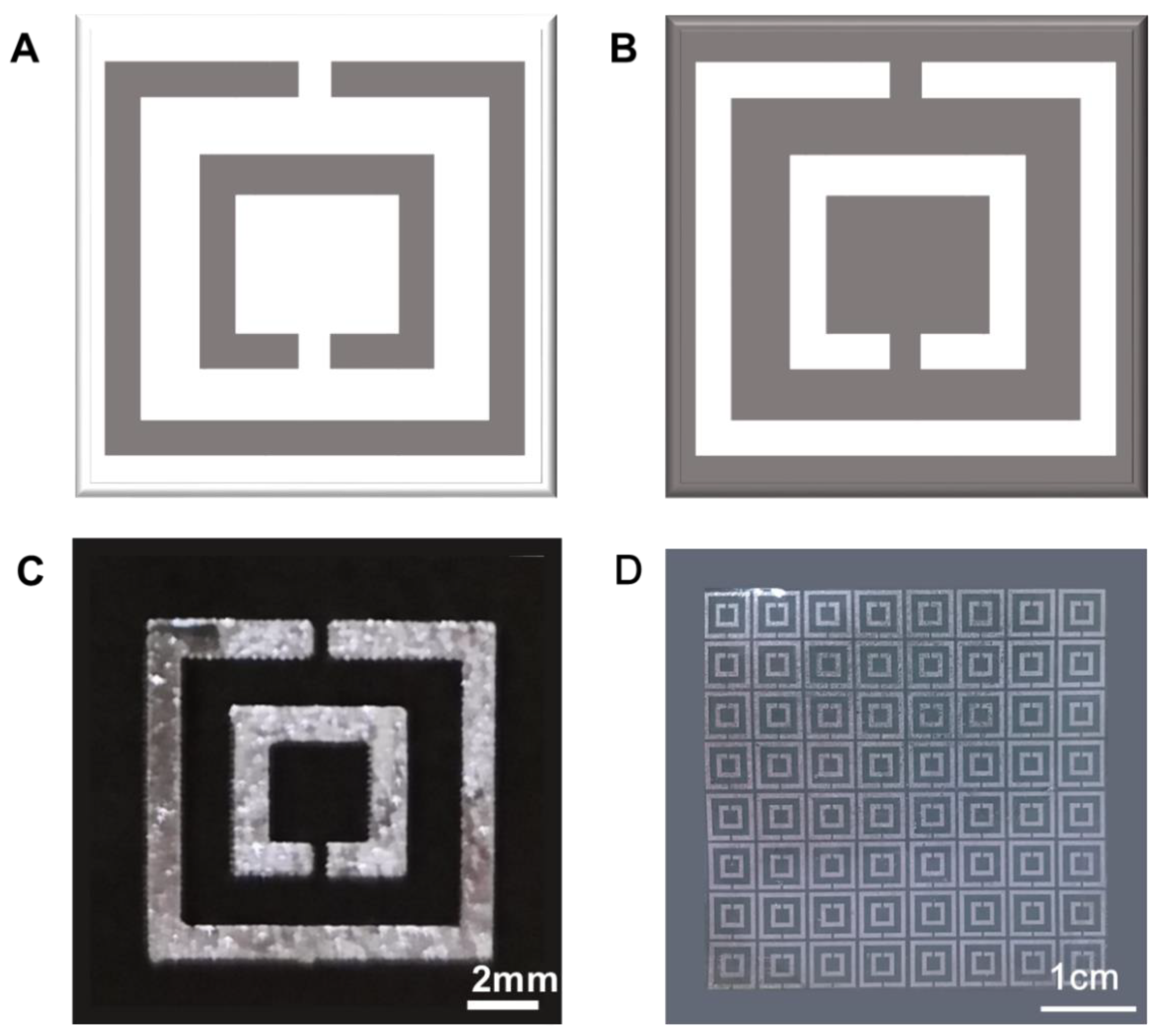
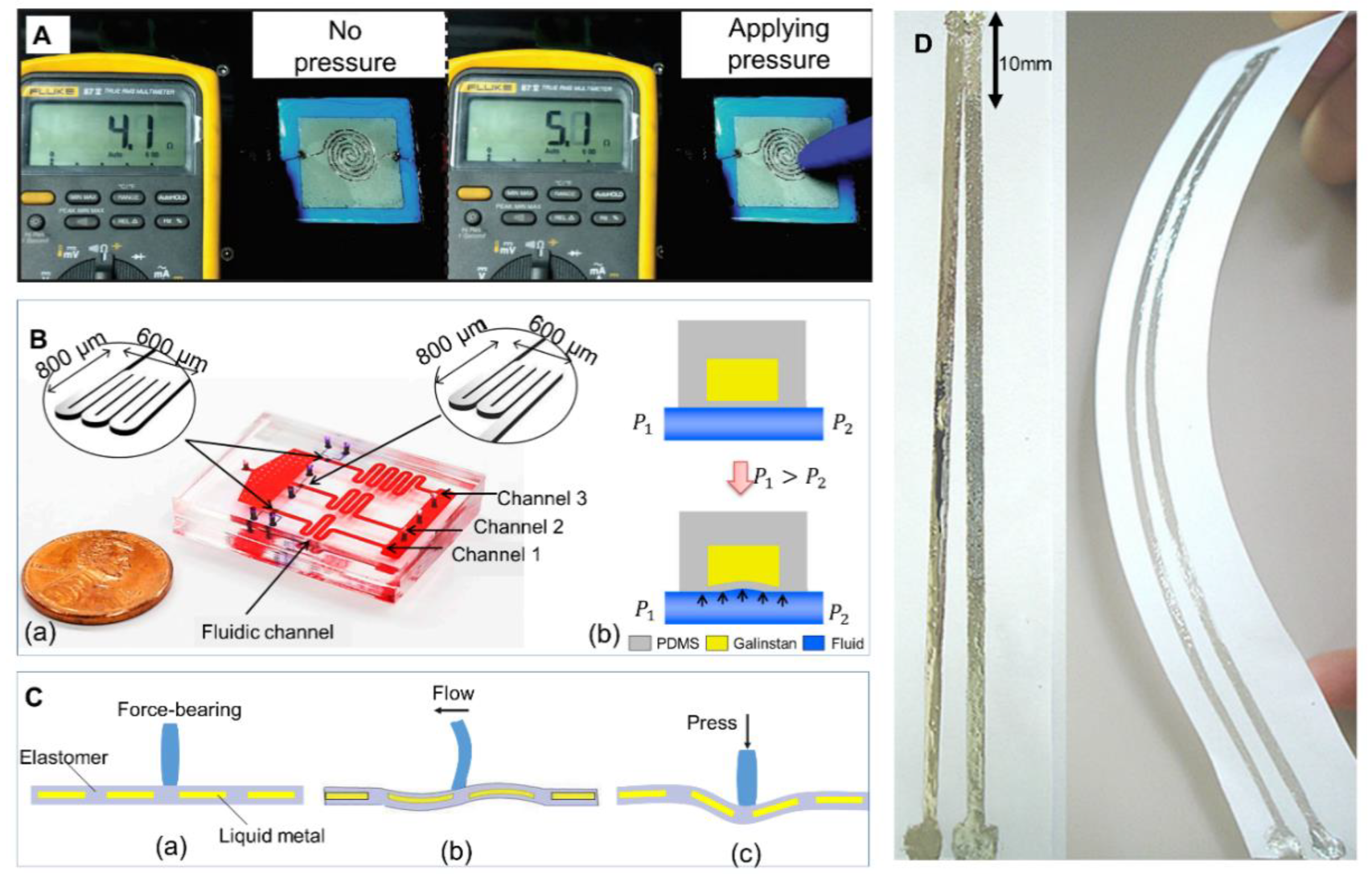
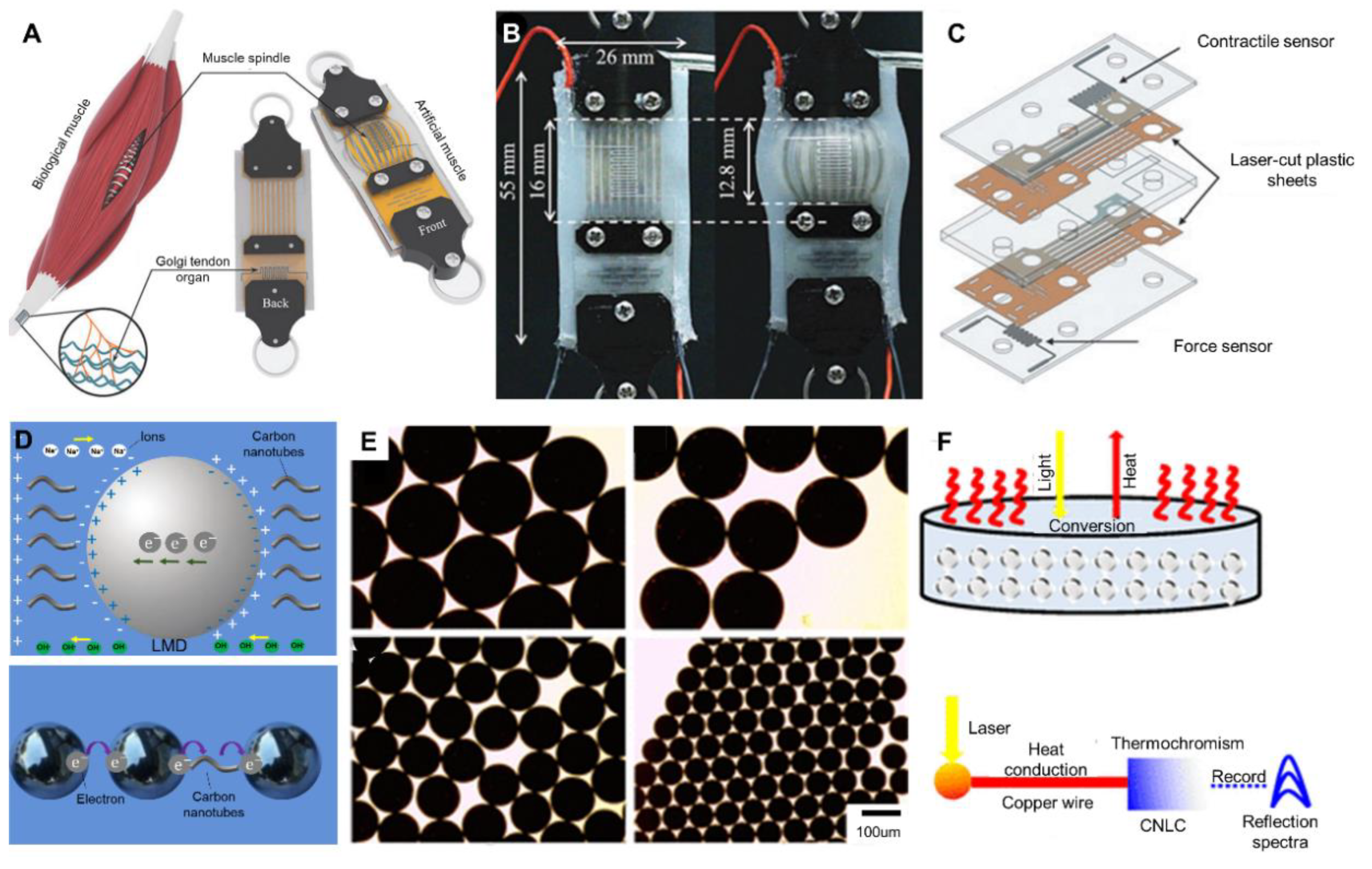
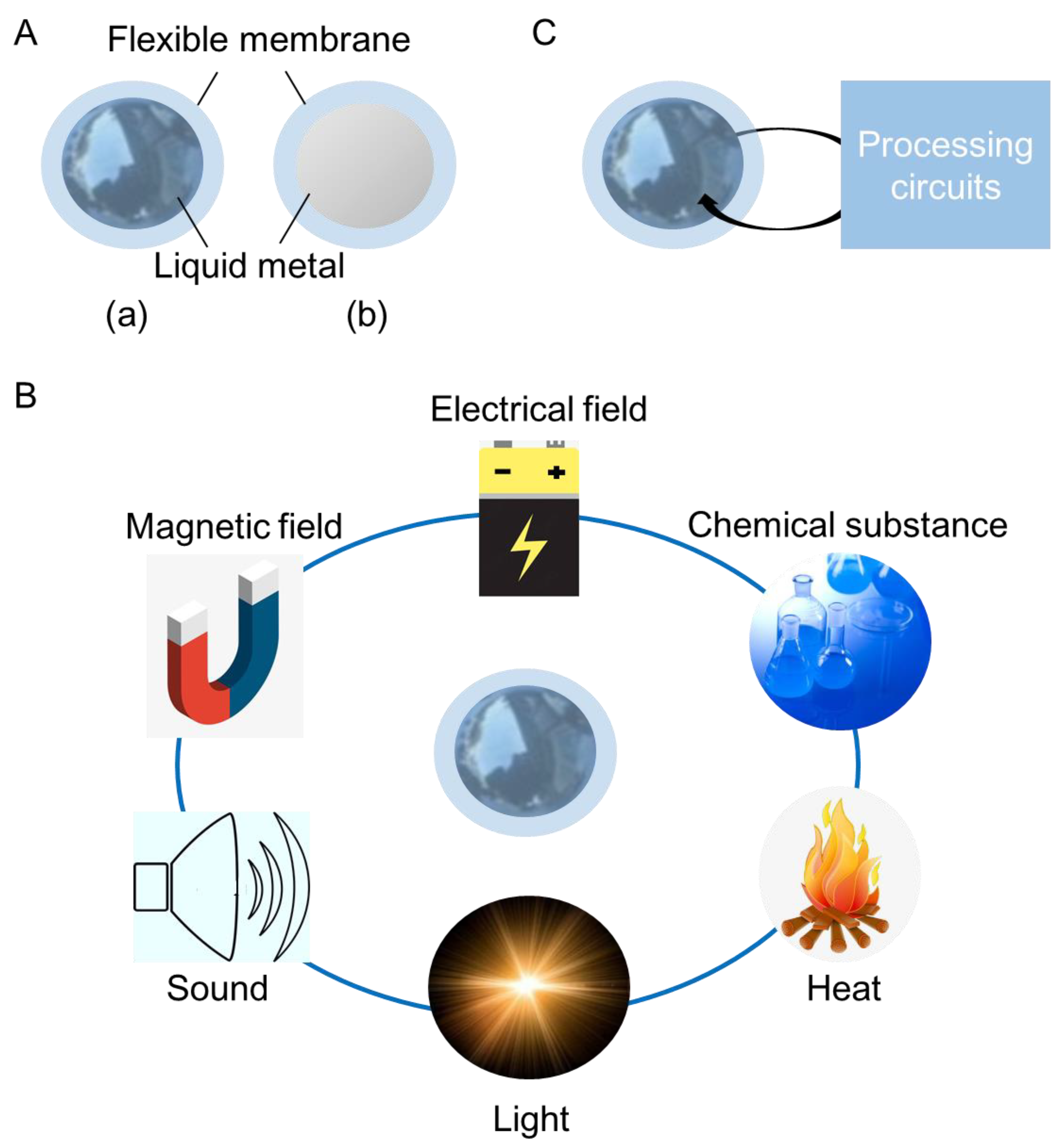
© 2020 by the authors. Licensee MDPI, Basel, Switzerland. This article is an open access article distributed under the terms and conditions of the Creative Commons Attribution (CC BY) license (http://creativecommons.org/licenses/by/4.0/).
Share and Cite
Ren, Y.; Sun, X.; Liu, J. Advances in Liquid Metal-Enabled Flexible and Wearable Sensors. Micromachines 2020, 11, 200. https://doi.org/10.3390/mi11020200
Ren Y, Sun X, Liu J. Advances in Liquid Metal-Enabled Flexible and Wearable Sensors. Micromachines. 2020; 11(2):200. https://doi.org/10.3390/mi11020200
Chicago/Turabian StyleRen, Yi, Xuyang Sun, and Jing Liu. 2020. "Advances in Liquid Metal-Enabled Flexible and Wearable Sensors" Micromachines 11, no. 2: 200. https://doi.org/10.3390/mi11020200
APA StyleRen, Y., Sun, X., & Liu, J. (2020). Advances in Liquid Metal-Enabled Flexible and Wearable Sensors. Micromachines, 11(2), 200. https://doi.org/10.3390/mi11020200




